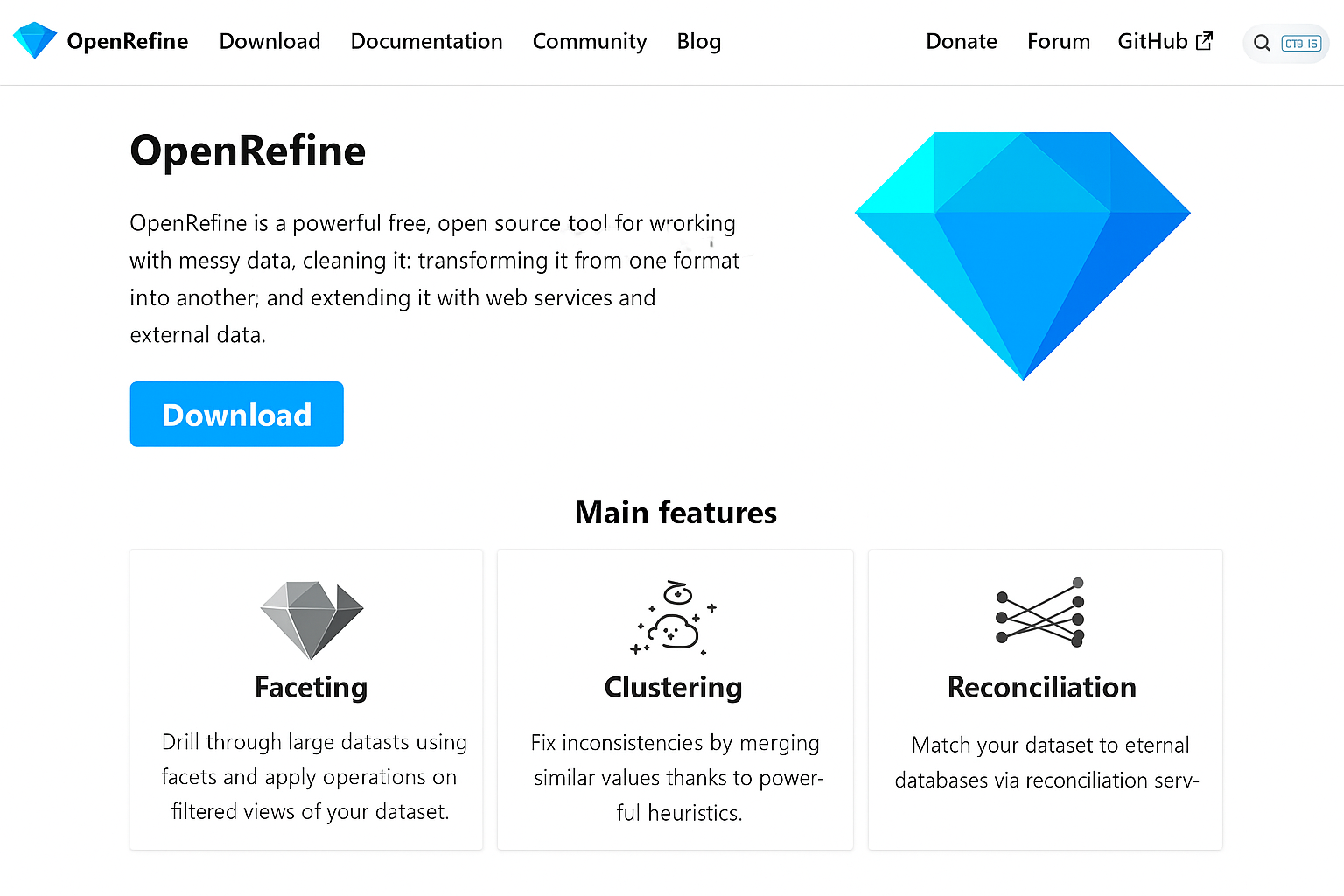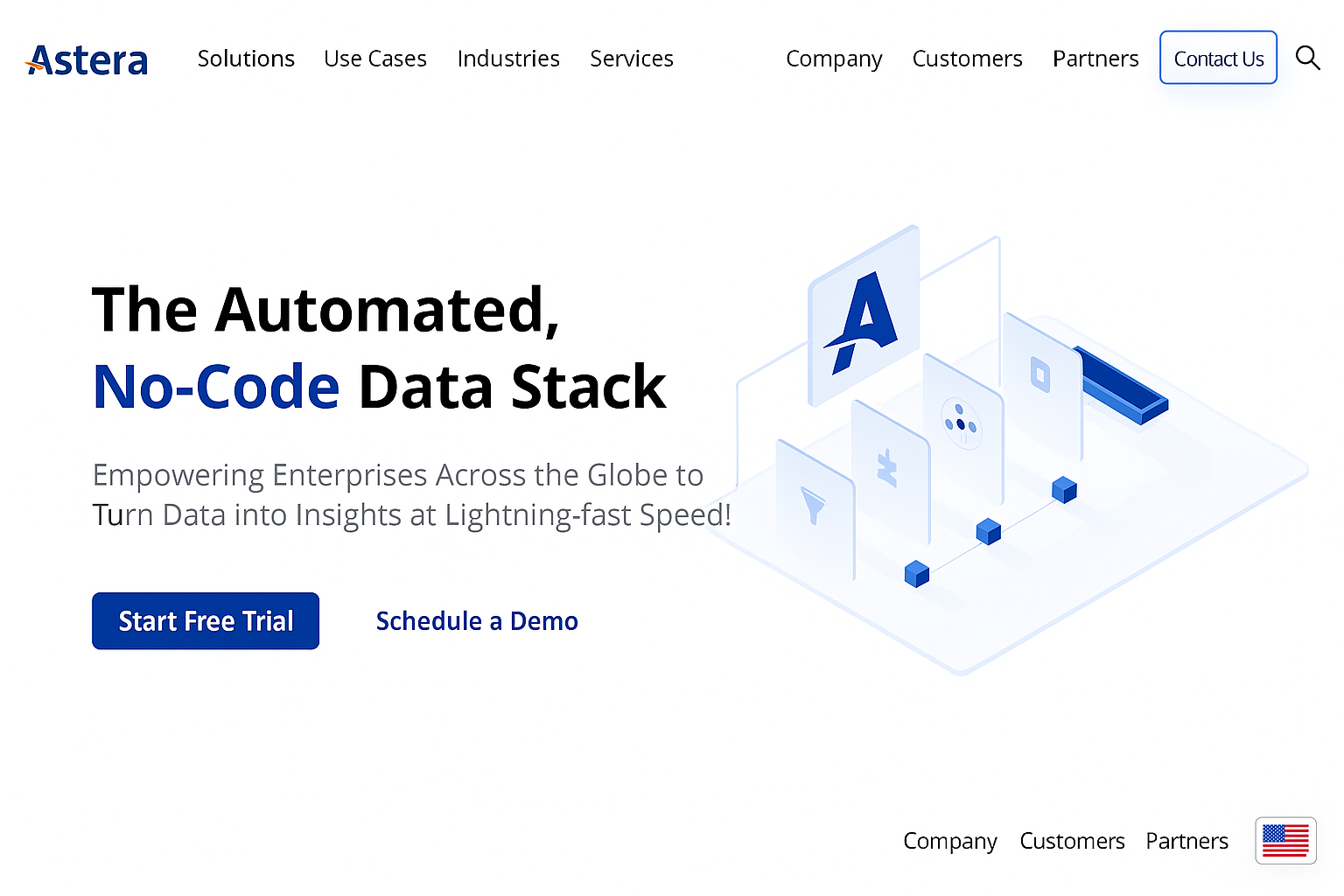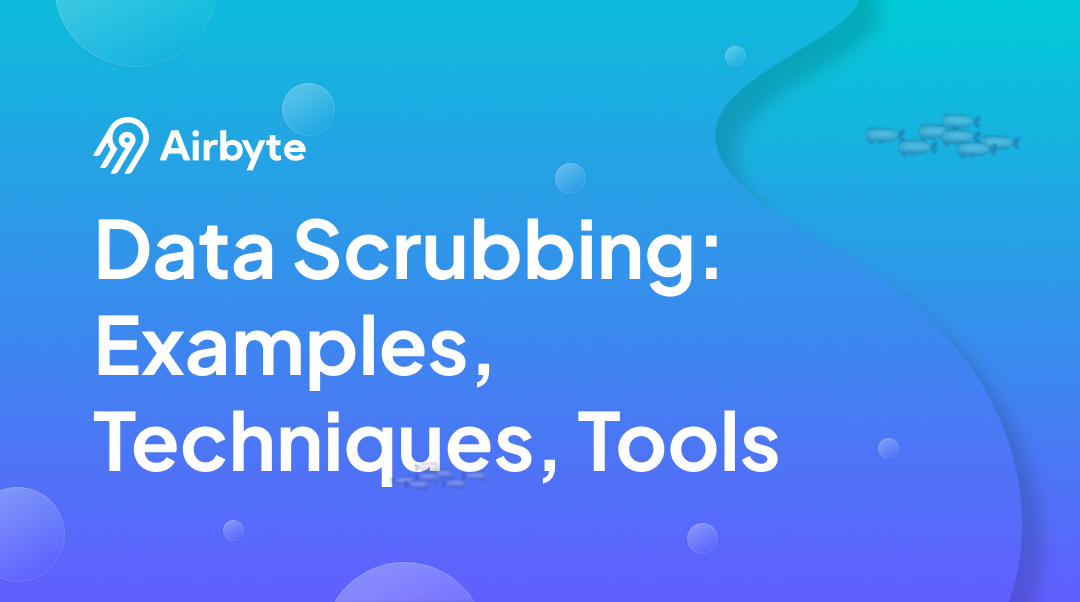What is Data Scrubbing: Examples, Techniques, & Tools
Summarize this article with:
✨ AI Generated Summary
Data scrubbing is essential for transforming raw, inconsistent datasets into clean, reliable information, enabling accurate decision-making and operational efficiency. Key benefits include:
- Ensuring data consistency through standardization and error correction.
- Enhancing decision accuracy and streamlining data integration.
- Reducing costs by preventing errors and minimizing manual data fixes.
Advanced methodologies leverage AI, machine learning, and real-time processing for scalable quality improvements, while sustainable practices focus on root-cause analysis and governance frameworks. Tools like OpenRefine, Astera Centerprise, Data Ladder, and Airbyte embed scrubbing into data pipelines, supporting continuous data quality management and competitive advantage.
Organizations struggle with an overwhelming reality: while they collect data from hundreds of sources daily, poor data quality—including issues such as duplicates, inconsistencies, and missing values—is widely recognized as a significant contributor to decision-making errors and costly business outcomes. This challenge becomes exponentially more complex as data volumes grow from gigabytes to petabytes, creating a bottleneck that prevents teams from extracting meaningful insights and driving competitive advantage.
Data scrubbing emerges as the critical solution that transforms chaotic, unreliable datasets into trustworthy information assets. By implementing systematic data scrubbing processes, you can eliminate the errors and inconsistencies that undermine analytical accuracy, ensuring your organization makes decisions based on clean, standardized, and reliable data.
In this article, you will explore comprehensive data scrubbing concepts, advanced methodologies, sustainable quality management practices, and the tools that enable efficient data cleaning at scale.
What Is Data Scrubbing and Why Does It Matter?
Data scrubbing is the systematic process of identifying, correcting, and removing inaccuracies, inconsistencies, duplicates, and missing values from datasets. This foundational practice transforms raw, unreliable data into clean, standardized information that supports accurate analysis and informed decision-making across your organization.
Modern data scrubbing extends beyond simple error correction to encompass comprehensive quality assurance throughout your data lifecycle. Rather than treating cleaning as an isolated activity, effective scrubbing integrates quality controls directly into data pipelines, ensuring continuous monitoring and correction as information flows from source systems to analytical destinations.
The importance of data scrubbing intensifies as organizations increasingly depend on data for artificial intelligence training, regulatory compliance, and real-time business operations. Poor data quality costs organizations an average of $12.9 million annually, while clean data enables faster insights, more accurate predictions, and stronger competitive positioning in data-driven markets.
What Are the Key Benefits of Implementing Data Scrubbing?

Ensure Data Consistency
Data consistency maintains uniform standards across all datasets, regardless of their original sources. You can utilize data scrubbing procedures to standardize formats, enforce naming conventions, and eliminate typographical inconsistencies that create confusion during analysis. This standardization becomes particularly crucial when integrating information from multiple departments, vendors, or geographic regions where different data entry practices may have evolved independently.
Boost Decision-Making
Clean, high-quality datasets enable your organization to make confident decisions based on accurate information rather than assumptions or incomplete data. Data scrubbing eliminates misspellings, corrects syntax errors, removes blank cells, and properly handles null values. This comprehensive cleaning process ensures that your analytics reflect true business conditions, enabling you to identify genuine trends and opportunities while avoiding costly mistakes based on flawed data.
Streamline Data Integration
You can implement data scrubbing as an integral component of your data integration process, where information from multiple sources gets collected, transformed, and loaded into centralized destinations. During the transformation phase, various scrubbing techniques clean source data and ensure compatibility with target systems. This integration approach prevents quality issues from propagating downstream and reduces the complexity of maintaining clean data across multiple platforms.
Cost-Effective Operations
While implementing data scrubbing requires initial investment in tools and processes, the long-term cost savings significantly outweigh these expenses.
Effective scrubbing helps you identify anomalies early, eliminate redundant processing of duplicate data, and prevent costly errors that result from acting on inaccurate information. Additionally, clean data reduces the time analysts spend investigating and correcting quality issues, allowing them to focus on generating business value rather than troubleshooting data problems.
What Are the Most Effective Data Scrubbing Techniques?
Data Standardization
Data standardization ensures consistency in formats, units, and representations across all datasets. This technique involves converting dates to uniform formats, applying consistent measurement units throughout your data, and establishing standard conventions for categorical values. For example, you might standardize all phone numbers to include country codes and consistent formatting, or convert all currency values to a single denomination for accurate financial analysis.
Data Enrichment
This enhancement technique adds valuable information to existing records, increasing their analytical utility and completeness. Data enrichment involves appending demographic information to customer records, adding geographic details to addresses, or incorporating external reference data that provides additional context for analysis. This process transforms basic datasets into comprehensive information resources that support deeper insights and more sophisticated analytics applications.
Error Correction
Systematic error detection and correction form the foundation of effective data scrubbing. This involves identifying and fixing misspellings, removing extra spaces, correcting invalid values, and addressing outliers that fall outside expected ranges. Advanced error correction employs pattern recognition to detect inconsistencies automatically, while validation rules ensure that corrections maintain data integrity and business logic consistency throughout your datasets.
Data Masking
When scrubbing sensitive information, data masking protects confidential data while preserving its analytical utility. You can apply techniques such as pseudonymization, tokenization, or format-preserving encryption to safeguard personal information, financial data, or proprietary business details. This approach enables you to perform necessary data quality operations while maintaining compliance with privacy regulations and security requirements.
What Advanced Data Scrubbing Methodologies Can Transform Your Data Quality?
Machine Learning-Powered Data Enhancement
Artificial intelligence and machine learning technologies are transforming data scrubbing by automating complex quality improvements that can surpass traditional rule-based approaches. Supervised learning models trained on historical data patterns can predict and correct missing values with remarkable accuracy, while unsupervised anomaly detection algorithms can automatically identify irregular records for human review, although their accuracy may not consistently exceed that of manual or supervised methods.
These AI-driven approaches adapt continuously to evolving data characteristics, learning from correction patterns to improve accuracy over time. For instance, fuzzy matching algorithms combine approximate string matching with machine learning to reconcile similar records across databases, resolving variations in customer names, product descriptions, or location references that would challenge traditional exact-match approaches.
Advanced Record Linkage and Deduplication
Sophisticated deduplication techniques employ multiple algorithms working in concert to identify and merge related records across disparate systems. Probabilistic matching algorithms calculate similarity scores across multiple attributes, enabling you to link records even when individual fields contain variations or errors. These methods prove particularly valuable when consolidating customer information from multiple touchpoints, where slight differences in data entry create apparent duplicates.
Advanced implementations incorporate hierarchical clustering to group similar records before applying deterministic matching rules, significantly improving both accuracy and processing efficiency. Additionally, temporal analysis capabilities track record changes over time, distinguishing between legitimate updates and erroneous duplicates while preserving historical data lineage for audit purposes.
Real-Time Stream Processing for Data Quality
Modern data scrubbing extends beyond batch processing to handle continuous data streams from IoT devices, web applications, and real-time business systems. Stream processing frameworks apply quality rules as data flows through pipelines, preventing low-quality information from reaching analytical destinations. This approach enables immediate detection and correction of issues like sensor calibration errors, transaction validation failures, or formatting inconsistencies in API responses.
Real-time scrubbing implementations utilize sliding-window analysis to maintain context across temporal data sequences, enabling quality rules that depend on historical patterns or cross-record relationships. Advanced systems incorporate machine learning models that adapt quality thresholds based on changing data characteristics, ensuring continued effectiveness as business conditions evolve.
How Can You Build Sustainable Data Quality Management Practices?
Root-Cause Analysis for Proactive Quality Control
Rather than continuously correcting the same data quality issues, sustainable scrubbing practices focus on identifying and addressing underlying causes of data problems. Systematic root-cause analysis employs techniques like the "5 Whys" methodology to trace quality issues back to their source systems, processes, or human factors that generate poor data initially.
Fishbone diagrams help visualize contributing factors across people, processes, technology, and environmental categories, while Pareto analysis prioritizes improvement efforts based on the frequency and business impact of different quality issues. This analytical approach enables you to implement preventive measures that reduce the volume of data requiring corrective scrubbing, improving overall system efficiency and data reliability.
Effective root-cause analysis also incorporates data lineage tracking to understand how quality issues propagate through complex data processing workflows. By mapping data transformations and dependencies, you can identify specific processing steps that introduce errors and implement targeted improvements that prevent quality degradation throughout your data pipeline.
Governance Frameworks and Continuous Monitoring
Sustainable data quality requires structured governance frameworks that establish clear accountability, standardized processes, and measurable quality objectives. Data stewardship programs assign specific individuals responsibility for maintaining quality within their domain expertise, while cross-functional quality councils coordinate improvement initiatives across organizational boundaries.
Comprehensive monitoring systems track quality metrics continuously, providing real-time visibility into scrubbing effectiveness and emerging quality trends. Automated alerting mechanisms notify relevant stakeholders when quality scores fall below acceptable thresholds, triggering corrective actions before issues impact business operations. These monitoring capabilities integrate with data cataloging systems to maintain comprehensive documentation of quality rules, transformation logic, and improvement initiatives.
Advanced governance implementations incorporate feedback loops that connect downstream data usage patterns with upstream quality improvement priorities. By analyzing how different quality issues impact specific business use cases, you can optimize scrubbing investments to deliver maximum value for organizational objectives while maintaining compliance with relevant regulatory requirements.
What Real-World Data Scrubbing Examples Address Common Business Challenges?
Standardizing Formats Across Multiple Systems
Date format variations create significant analytical challenges when consolidating information from diverse sources. Consider gathering customer purchase data from multiple e-commerce platforms where dates appear as MM-DD-YYYY, YYYY-DD-MM, or DD/MM/YYYY formats. Effective data scrubbing standardizes these variations into consistent formats that enable accurate temporal analysis, trend identification, and seasonal pattern recognition across your entire customer base.
Similar standardization challenges arise with address formats, phone number representations, and measurement units that vary across geographic regions or business systems. Systematic scrubbing processes apply transformation rules that preserve the underlying information while ensuring analytical consistency throughout your datasets.
Handling Inconsistent or Missing Values
Null or missing values significantly complicate analysis and reporting processes, particularly when determining customer eligibility, calculating averages, or building predictive models. For example, when analyzing customer income data to assess product affordability, missing values can skew your results and lead to incorrect business decisions.
Advanced scrubbing techniques address these gaps through contextual imputation strategies that consider related data attributes, historical patterns, and business logic. Rather than simply filling missing values with defaults, sophisticated approaches estimate appropriate values based on similar customer profiles, geographic patterns, or temporal trends that maintain analytical integrity.
Improving Data Quality Issues That Impact Operations
Data quality problems directly affect operational efficiency and increase business costs through errors, delays, and rework. Customer databases often contain typos in names or addresses, inconsistent contact information, and incomplete profile data that hampers marketing effectiveness and customer service quality.
Comprehensive scrubbing identifies and corrects these issues systematically, validating email formats, standardizing address formats, and reconciling conflicting information across multiple customer touchpoints. This thorough cleaning enables personalized marketing campaigns, accurate customer analytics, and improved operational efficiency throughout your customer-facing processes.
What Are the Top Data Scrubbing Tools for Modern Organizations?
1. OpenRefine

OpenRefine provides a comprehensive, free, and open-source platform for interactive data cleaning and transformation. This powerful tool enables you to merge duplicate records, correct misspellings, remove redundant entries, and standardize inconsistent data formats through an intuitive graphical interface. OpenRefine excels at handling large datasets while providing detailed logs of all transformation operations for audit and repeatability purposes.
2. Astera Centerprise

Astera Centerprise delivers a comprehensive no-code data integration platform that incorporates advanced cleaning capabilities throughout the data pipeline process. The platform addresses diverse quality challenges including duplicate removal, data type inconsistencies, whitespace cleanup, and formatting standardization. Its visual workflow designer enables business users to implement complex scrubbing logic without technical programming expertise while maintaining enterprise-grade performance and scalability.
3. Data Ladder

Data Ladder specializes in comprehensive data profiling, cleansing, matching, and deduplication capabilities designed for enterprise-scale operations. The platform automatically detects various anomalies including null values, formatting inconsistencies, and punctuation errors while providing detailed profiling reports that illuminate dataset structure and quality characteristics. Its advanced matching algorithms excel at identifying relationships between records across multiple data sources, making it particularly valuable for master data management initiatives.
How Can Airbyte Transform Your Journey from Messy Datasets to Accurate Insights?
Airbyte represents a revolutionary approach to data integration that embeds data scrubbing capabilities throughout the entire data movement process. This cloud-based platform utilizes a modern ELT architecture that preserves raw data integrity while enabling flexible transformation and cleaning operations downstream.

Comprehensive Data Integration with Embedded Scrubbing
Airbyte's extensive ecosystem of 600+ pre-built connectors eliminates the complexity of custom integration development while incorporating quality controls throughout the data pipeline. The platform's Connector Development Kit enables rapid creation of custom connectors tailored to your specific business requirements, ensuring comprehensive data coverage without compromising on quality standards.
The platform's unique approach to data scrubbing involves preserving raw data in staging areas while applying transformations through integrated tools like dbt. This methodology ensures data lineage visibility and enables iterative quality improvements without losing access to original source information.
Advanced Features for Enterprise Data Quality
- Change Data Capture Integration: Airbyte's CDC capabilities enable real-time data synchronization with embedded quality controls, ensuring that scrubbing operations maintain currency with source system changes while preventing quality degradation over time.
- Flexible Data Transformation: Deep integration with dbt provides sophisticated transformation capabilities that enable complex scrubbing logic, data validation rules, and quality metric calculation directly within your data pipeline workflows.
- Multi-Modal Pipeline Management: You can build and manage scrubbing-enabled pipelines through multiple interfaces including API automation, Terraform infrastructure-as-code, PyAirbyte programmatic control, or intuitive user interface management, providing flexibility for different technical skill levels and operational requirements.
- Comprehensive Data Type Support: The platform handles structured, semi-structured, and unstructured data sources seamlessly, applying appropriate scrubbing techniques based on data characteristics while maintaining processing efficiency across diverse information types.
Airbyte's open-source foundation ensures that your data scrubbing investments remain portable and customizable, avoiding vendor lock-in while providing access to community-driven innovations and enterprise-grade security capabilities.
Final Words
Data scrubbing serves as the cornerstone of reliable data management, transforming chaotic information into trustworthy business assets. By implementing comprehensive scrubbing strategies that combine traditional techniques with advanced AI-powered methodologies, you ensure data accuracy and integrity that enables confident decision-making and competitive advantage.
The evolution toward sustainable data quality management through root-cause analysis and structured governance frameworks positions scrubbing as a strategic capability rather than a tactical necessity. Modern tools and platforms like Airbyte integrate these quality assurance practices directly into data pipelines, creating continuous improvement cycles that maintain excellence throughout your data lifecycle.
Frequently Asked Questions
What is the data scrubbing method?
Data scrubbing encompasses systematic processes for identifying, correcting, and removing inaccurate, redundant, incomplete, or inconsistent information from datasets. The method involves discovering data quality issues through profiling and analysis, then applying appropriate correction techniques such as standardization, validation, deduplication, and enrichment to improve overall data reliability and usefulness.
Is data scrubbing beneficial?
Yes, data scrubbing provides significant benefits including improved decision-making accuracy, reduced operational costs, enhanced regulatory compliance, and increased analytical reliability. Regular scrubbing maintains data integrity especially when consolidating information from multiple sources, preventing quality issues from compounding and ensuring that business insights reflect accurate underlying conditions.
What role does the data scrubbing process play in ETL?
Data scrubbing cleans and standardizes raw data during ETL, removing errors, duplicates, and inconsistencies. This ensures reliable, high-quality data for downstream systems, improving analytics accuracy and overall business decision-making.
What is a data scrubbing tool?
Data scrubbing tools are software applications that automate the detection, correction, and prevention of data quality issues using various algorithms and methodologies. These tools improve decision-making by ensuring data accuracy, streamline workflows by reducing manual cleaning efforts, and provide consistent quality standards across diverse datasets and sources.

.webp)
